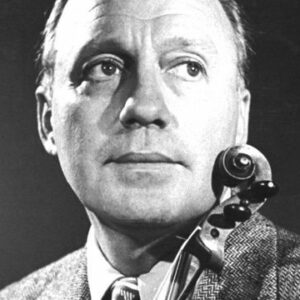Fred Allen was an American comedian who was born John Florence Sullivan. He began his career as an entertainer in vaudeville as a comic juggler and later starred on Broadway in revues such as ‘The Passing Show’ with his partner/wife Portland Hoffa. With the ‘Fred Allen Show,’ he quickly gained enormous popularity. ‘Allen’s Alley’, a weekly jokefest featuring the recurring characters Senator Claghorn, Mrs. Nussbaum, and Titus Moody Allen, was one of this series’ most popular features. His most enduring gag was his lengthy mock feud with friend and fellow comic Jack Benny. He continued his radio show until CBS’ ‘Stop the Music’ pushed it out of the ratings race. He had acted in films throughout his career, but did not enjoy scripted acting. Allen began his career in the 1950s as a guest star on other comedians’ radio and television series and later became a regular on ‘What’s My Line?’ Allen was a prolific writer who also wrote two best-selling memoirs in the last decade, ‘Much Ado About Me’ and ‘Treadmill to Oblivion’. His routines influenced fellow comics Groucho Marx, Stan Freberg, Henry Morgan, and Johnny Carson, as well as President Franklin D. Roosevelt and novelists William Faulkner, John Steinbeck, and Herman Wouk.
Childhood & Adolescence
Fred Allen was born John Florence Sullivan in Cambridge, Massachusetts. Cecilia Herlihy, his mother, died when he was three years old. His father, James Henry Sullivan, became depressed following the death of his wife.
His Aunt Lizzie raised him and his infant brother, Robert. Allen’s father eventually remarried and invited his sons to stay with him; however, Allen chose to stay with his aunt.
Career of Fred Allen
Allen enrolled in piano lessons, began working at the Boston Public Library, and began juggling.
He was asked to perform juggling and comedy for a show organized by his library colleagues. While he was performing, a member of the audience exclaimed, ‘You should go on stage,’ inspiring him to pursue comedy as a career.
He assumed the stage name Fred St. James and began performing for $30 per week on the local vaudeville circuit. He performed monologue comedy throughout the world.
In 1917, he returned to the New York circuit, renamed himself Fred Allen, and attempted to earn a higher salary.
In 1922, he commissioned an elaborate painting called ‘Old Joke Cemetery’ to cover the theater curtain. The painting depicts a cemetery with several punch lines on the gravestones.
He left vaudeville in 1922 and began working on stage productions for the Shubert Brothers, including ‘The Passing Show’. The show did exceptionally well in the run-up to Broadway but did not last long at the ‘Winter Garden Theatre.’
While awaiting an opportunity to perform in an Arthur Hammerstein musical, he made his first radio appearance on Chicago’s ‘WLS Showboat.’
Allen and his wife were approached about a Hammerstein production, ‘Polly,’ starring an actor named Archie Leach. Although ‘Polly’ never premiered, Allen went on to star in other critically acclaimed shows such as ‘The Little Show’ and ‘Three’s a Crowd’.
Allen made the transition to radio with ‘The Lint Bath Club Revue’ on CBS in 1932, and the show was renamed ‘The Salad Bowl Revue’ the following year. Allen’s perfectionism caused him to bounce from sponsor to sponsor.
Between 1933 and 1940, his show ‘The Salad Bowl Revue’ was renamed ‘The Sal Hepatica Revue’, ‘The Hour of Smiles’, and finally ‘Town Hall Tonight’.
In 1940, he hosted CBS’s ‘Texaco Star Theater,’ which was shortened to half an hour a few years later.
His final series, ‘The Fred Allen Show,’ aired from 1942 to 1949 and featured the young DeMarco Sisters harmoniously chiming “Oh, Mr. Allen?” as a lead-in to his clever opening line.
The show’s ratings declined as a result of ABC’s musical quiz show, ‘Stop the Music,’ and the growing popularity of television. He took a year off for health reasons and never returned to a full-time show.
He appeared in three significant films between 1940 and 1952: ‘Love Thy Neighbor’, ‘It’s in the Bag!’, and ‘We’re Not Married with Ginger Rogers’.
Between 1950 and 1952, after his own show ended, Allen began appearing on Tallulah Bankhead’s NBC show ‘The Big Show.’ He appeared in 24 of the show’s 57 installments.
His subsequent television projects were also a failure. He also attempted unsuccessfully to bring ‘Allen’s Alley’ back to television. He did, however, appear as a panelist on the CBS quiz show ‘What’s My Line?’ between 1954 and 1956.
He worked primarily as a newspaper columnist in his later years and published two memoirs, ‘Treadmill to Oblivion’ and ‘Much Ado About Me’.
Significant Works of Fred Allen
‘Allen’s Alley’, which debuted on ‘The Fred Allen Show’ in 1942, was a recurring sketch satirizing small town America in which the comedian and his wife encountered a colorful array of exaggerated characters.
Awards and Accomplishments
Allen was honored with two stars on the Hollywood Walk of Fame: a radio star at 6713 Hollywood Boulevard and a television star at 700 Hollywood Boulevard.
Personal History and Legacies
In 1927, he married Portland Hoffa, who appeared in his ‘Allen’ Alley’ sketch.
He died on March 17, 1956, of a heart attack and was laid to rest in Hawthorne, New York’s Gate of Heaven Cemetery.
Estimated Net Worth
Fred is one of the wealthiest radio hosts and is included on the list of the most popular radio hosts. Fred Allen’s net worth is estimated to be around $1.5 million, according to our analysis, Wikipedia, Forbes, and Business Insider.
Trivia
As this comedian once put it, “a celebrity is someone who works hard his entire life to achieve fame and then wears dark glasses to avoid recognition.”


